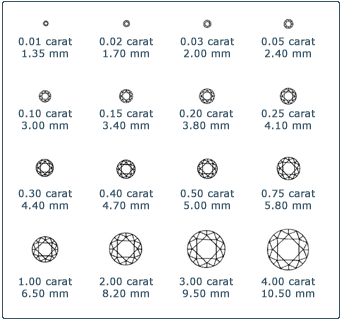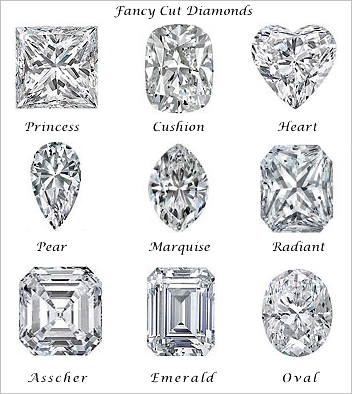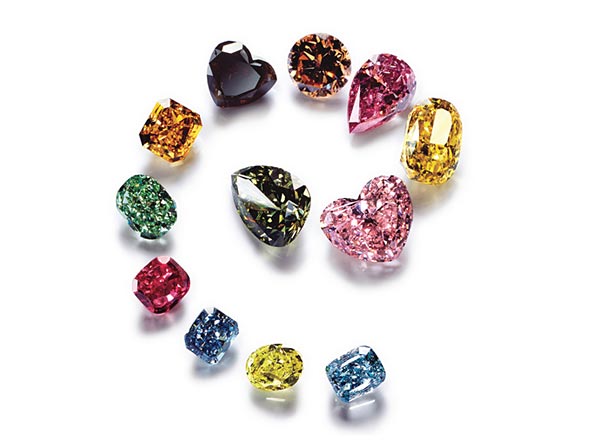This is going to be a small lesson on helping to understand how diamonds are valued and priced — and help you decide what’s most important to you in a diamond. The easiest way to explain diamonds is using the four Cs: cut, color, clarity, and carat.
CUT
Diamond cut is the most important factor to consider when buying a diamond. Let this not be confused with the diamonds shape, (ie. round, princess, pear). The quality of the cut of a diamond directly influences the way light enters and exits the diamond and therefore directly influences the way a diamond sparkles, shines, and provides the maximum brilliance you see. In determining the quality of the cut, the grader evaluates the cutter’s skill in the fashioning of the diamond; technology assesses the diamond’s light performance. The more precise the cut, the more captivating the diamond is to the eye.
Color
With the exception of some fancy colored diamonds, the most valuable diamonds are those with the least color. Although many people think of gem quality diamonds as colorless, truly colorless diamonds are actually very rare. Most diamonds used in jewelry are nearly colorless with tints of yellow or brown. The color scale for transparent diamonds runs from D-F (colorless), G-J (near colorless), K-L (faint yellow), to Z (light yellow). Completely colorless diamonds are rare.
When diamonds are formed with traces of other minerals, rare and beautiful colors can result. These “fancy” colors range from blue to brilliant yellow to red, brown, pale green, pink, and violet. Because of their rarity, colored diamonds are highly desirable and may be quite valuable. (see more info below)
Clarity
A diamond’s clarity is measured by the existence, or absence, of visible flaws. Diamonds can have internal characteristics known as inclusions or external characteristics known as blemishes. These tiny surface blemishes or internal inclusions — even those seen only under 10x magnification with a jeweler’s loupe — can alter the brilliance of the diamond and, thus, effect its value. Diamonds without inclusions or blemishes are rare; however, most characteristics can only be seen with magnification. Clarity levels begin with Flawless (F & IF) and move down to Very Very Slight (VVS1 & 2), Very Slight (VS1 & 2), Slightly Included (SI1 & 2), and Included (I1, 2 & 3).
Carat
 The carat is the diamonds physical weight measured in metric carats. One carat equals 1/5 gram. For diamonds under one carat, each carat is divided into 100 points – similar to pennies in a dollar. 0.75 ct. = 75 points, 1/2 ct. = 50 points. Caratweight is the most objective of the 4 Cs. It involves no estimates, comparisons or judgments. The value of larger diamonds are directly related to the rarity of these diamonds, so for example 3 half carat diamonds would have a significantly less dollar value than one 1.5 carat diamond with the same cut, color, and clarities.
The carat is the diamonds physical weight measured in metric carats. One carat equals 1/5 gram. For diamonds under one carat, each carat is divided into 100 points – similar to pennies in a dollar. 0.75 ct. = 75 points, 1/2 ct. = 50 points. Caratweight is the most objective of the 4 Cs. It involves no estimates, comparisons or judgments. The value of larger diamonds are directly related to the rarity of these diamonds, so for example 3 half carat diamonds would have a significantly less dollar value than one 1.5 carat diamond with the same cut, color, and clarities.
Fancy Shapes and Colored Diamonds
Recent years have brought on an overwhelming request for fancy shape and colored diamonds. See the above picture for a few of the many amazing cuts that are available. Black, pink, yellow, blue, green, and different shades of brown seem to be the the most popular colors that are desired for fine jewelry. These diamonds may be found naturally or different forms of high pressure and high temperatures treatments can be used to obtain these fancy colors. The treatment used offers a couple benefits, it provides a permanent color change to the diamond and also allows an affordable option to obtain diamonds that are so rare and expensive.






